Description: War Thunder is a next generation military MMO game dedicated to...

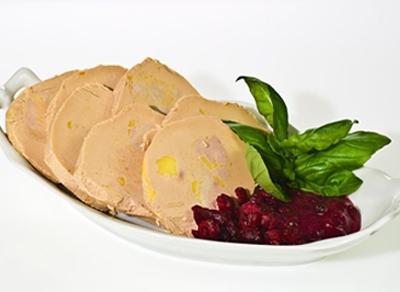
Increasingly, in our country, various overseas delicacies began to be used in cooking. They appeared on the shelves of shops and supermarkets, although many of us do not even suspect what they are made of and, most importantly, how to cook them. Here, for example, foie gras - what is it and what is it eaten with? Foie gras is a pâté made from the very fatty liver of ducks or geese. This product is also called "pate from Strasbourg". This delicacy is quite highly valued all over the world, especially the French fell in love with it.
For the manufacture of foie gras (which means “fatty liver” in French), a special scheme for feeding ducks or geese has long been developed, which are given at least four kilograms of grain or other feed three times a day. The liver increases in volume by 10 times its normal size.
Foie Gras evokes different emotions in people. Many foodies simply adore her, but there is also a group of people made up of animal rights activists who seek to legitimize the ban on fattening birds in such an inhumane way around the world. Their desire was partially realized, and in many countries it is forbidden to produce foie gras. The largest producer of this liver is France, followed by Hungary, and a small amount of this product is produced in Israel.
How to cook foie gras at home? Foie gras is most commonly associated with the word "pate", although it can be prepared in many different ways. The types of this liver differ in the method of obtaining, processing, quality and quantity of the product. Foie gras is sold in three different forms- raw product, semi-finished product and ready meal. It goes well with fresh bread, as well as various vegetables and even sweet jams or preserves. Foie gras is served with dessert white wine, port or Madeira.
What can be cooked with foie gras? Recipes for this dish are very varied. First you need to make a choice between goose and duck liver. Foie gras from goose is a little more delicate in taste than liver
To cook foie gras, you need to clean the raw liver from tendons, remove excess fat and any greenish-yellow spots. Then it must be soaked in cold water or milk, before removing the shell. The processed liver can be simply fried in a pan in hot oil for just a few minutes.
Cook julienne or just scrambled eggs with foie gras - recipes are so simple, but hearty snacks varied and quite interesting. Julienne will look chic even on the festive table. To prepare it, you will need oil, foie gras and eggs. Put the butter in the pots, put the foie gras slices on it, break the egg into each serving pot, without violating the integrity of the yolk. Add pepper and sprinkle with sea salt. Bake for 10-15 minutes in a preheated oven at 180°C. Serve hot. The variations with egg and liver are truly endless. You can add cream to such dishes or replace the omelette with a poached egg. Some prepare breakfasts with hard cheese and foie gras. Julienne recipes are also good because these dishes can be prepared from the leftover products after dinner for breakfast.
The most popular are various soufflés, pastes and foie gras terrines. The recipes for their preparation are different, but simple. Let's try to cook terrine.
Remove the foie gras from the refrigerator an hour before cooking and soak in a mixture of milk and water to remove blood. Separate two blades, remove veins and fat deposits. Prepare the sauce by mixing fatty liver juice, pepper and five different spices. Cut the foie gras and marinate in the sauce, putting in a cold place. Remove the liver and wrap it tightly in a clean cloth to add volume, place in boiling water and immediately turn off the heat. Cover with a lid and let cool to room temperature. Then take the foie gras out of the water, put it on a towel and wrap it again. Refrigerate the liver for at least 12 hours. Enjoy your meal.
Foie Gras - goose liver pate and a symbol of gastronomic chic - is considered an invention French chefs, because it is an attribute of luxury and a traditional Christmas dish in France. In fact, the French only inherited the recipe for this delicious dish from the Romans, who learned it from the Jews, and they, in turn, from the Egyptians.
About 4,000 years ago, the Egyptians noticed that the geese and ducks that migrate north through the Nile Valley and stop to rest and eat before the long flight of figs, which abound in these lands, have tastier livers than domestic geese. To achieve the same effect with poultry, the Egyptians began to fatten geese and ducks with figs, and they did it forcibly.
To get a large, juicy, soft and fatty liver, birds had to eat huge amounts of figs for several weeks. This technology was adopted by the Jews, who then lived in Egypt. Since the religion forbids them to eat pork fat and butter for frying, they raised geese in this way for fat, but not for their liver. Until the 19th century, goose liver was considered non-kosher, and Jewish poultry farmers profitably sold it. From the Jews, the technology of rearing poultry passed to the Romans, and goose liver pate became one of the favorite dishes of the ancient world.
Goose liver foie gras (oie) has a more refined creamy flavor and softer texture than duck liver foie gras (canard), which has a pronounced musky aroma and distinct taste. The debate about whose liver is best for foie gras has been going on since the time of Pliny.
Today, preference is given to duck liver, as its production is more economical. About 90% of foie gras is made today from the liver of ducks. Foie Gras literally means "fatty liver" in French. Few people know that the word "liver" in French(and other languages of the Romance group) is derived from the Latin word for figs (figs). Latin name"Jecur Ficatum" (liver derived from figs) shortened to "Ficatum", which became "foie" in French.
We can say that today the name foie gras does not justify itself, since instead of figs, birds are fed boiled corn and even mixtures of soy and vitamin supplements. The first goose pâté recipes date back to the 4th and 5th centuries. These recipes do not provide a detailed description of the entire process of preparing the delicacy; detailed recipes appeared only in French cookbooks of the 17th and 18th centuries. That is why France is considered to be the birthplace of foie gras. In 19th century France, foie gras became a fashionable dish among the nobility, and many variations of the preparation of this dish appeared.
Some restaurants have been sticking to signature recipes for over 100 years. In the southwest of France and in Alsace there is a real cult of foie gras. In Alsace, they even grow a special breed of geese - Strasbourg, which gives a liver weighing up to 1200 grams. Among ducks, the best breed for foie gras is considered mular (a hybrid of Peking and Moscow ducks). Various regions of France are famous for various types foie gras.
Airy foie gras is made in Toulouse Ivory; in Starsburg, pink and hard. Foie gras from Bordeaux goes well with hot dishes; from Perigord - to cold. France is the largest producer and consumer of foie gras in the world. In addition to France, foie gras is produced in Hungary, Spain, Belgium, the USA and Poland. In Israel, the production of foie gras is hindered by animal advocates: this dish is prohibited there.
It is also illegal to produce and eat foie gras in Argentina, Norway and Switzerland. The process of force-feeding the bird is called "gavage". While the practice is considered unethical and banned in some countries, farmers and foie gras enthusiasts claim that force-feeding does not make the birds uncomfortable. Geese and ducks do not chew food, but grind it in the stomach with the help of small pebbles that they swallow.
With artificial feeding, food is introduced twice a day in large quantities. An enlarged liver does not affect the health of geese and ducks in any way and has nothing to do with cirrhosis. AT vivo waterfowl migratory birds also overeat before long journeys, it is no coincidence that the liver of these birds is used for foie gras, and not chickens, for example.
Compared to many domestic animals, the life of geese and ducks raised for foie gras seems like a fairy tale: for several months they graze in the meadows, move a lot, and only the last 2-3 weeks live in small enclosures. After special feeding, the liver of birds increases by 10-15 times. If the birds are released into the wild after the cubage, after a few weeks their liver will return to normal.
Foie gras is not only a gastronomic delight, but also a very healthy dish.
Liver waterfowl rich in unsaturated fatty acids, which lower blood cholesterol levels and provide healthy eating cells. Saturated fatty acids in duck fat 2 times less than in butter, and unsaturated - 2 times more. The benefits of foie gras are evidenced by the fact that in regions where this dish is especially popular, the level of cardiovascular diseases is very low. high duration life.
The production of foie gras in France is regulated by law. Most best product- whole goose or duck liver without additives (foie gras entier). It can be sold raw, cooked or semi-cooked. Foie gras with pieces consists of ground liver and whole pieces of liver, the content of which must be at least 30%. The foie gras block (bloc de foie gras) consists of ground liver, and the content of goose liver must be at least 50%. Truffles, cognac and other products can be added to foie gras.
Foie gras is used to make mousse, pate, parfait, galantine, terrine or medallion - products with different ways cooking and various contents of the liver. For example, to make mousse, the liver is whipped with cream, proteins and alcohol; terrine - baked pate with a rough structure based on several types of liver. As a rule, pork or beef liver is added to pâtés and foie gras mousses. French chefs use foie gras to make amazing dishes: siphon terrine for a low-fat foam; frozen and form parfait in the form of sweets stuffed with almonds, dried fruits and orange chips.
For the preparation of foie gras of the highest grade, the freshest liver is required. It should be cut into thin slices and fried in olive or butter. Pieces of liver should retain a delicate silky texture under a crispy crust. This method seems simple, but in fact it requires skill, because the delicacy should not melt in a pan or be too greasy.
Hot, freshly prepared foie gras is served as a main course with confiture, fruit, mushrooms or chestnuts. Sweet berry and fruit sauces, marmalade, nuts, spices (allspice, fennel, cinnamon, cloves) are combined with this dish. Well-cooked foie gras is best enjoyed early in the meal when the taste buds are at their most sensitive.
Another method involves marinating the liver in cognac with spices for 10-12 hours, after which truffles and Madeira are added to it and rubbed for a long time until a tender mass is obtained, which is placed in a water bath in the oven for 50-60 minutes. Foie gras prepared in this way is served as an appetizer or aperitif, cold, but not too icy. It is cut into thin slices and laid (not smeared) on bread, cold toast, apple slices or lettuce with the thinnest possible knife, which should be rinsed and wiped after cutting each piece to maintain shape.
It is better to take foie gras out of the refrigerator 15-20 minutes before serving, and cut at the last moment. If the foie gras is too soft, it is cut with a butter-cutting wire (lyre). In French stores, you can find foie gras in all sorts of forms: from raw to canned. Raw liver (Foie gras cru) offers a lot of culinary creativity, but does not tolerate delay in preparation.
Semi-finished foie gras (foie gras mi-cuit) is a semi-finished product that has undergone minimal processing and also requires immediate preparation. Semi-preserved foie gras (foie gras semi-conserve) is a pasteurized product, ready to eat, with the possibility of storage for several months in the refrigerator. Canned foie gras (foie gras en conserve) - a sterilized product in metal cans, far from original recipe but well tolerated storage.
Such an exquisite delicacy as foie gras requires careful selection of wines.
Young, sour and too light wines will spoil the impression of foie gras. A worthy addition would be Armagnac, Sauternes, white liqueur wines Château d'Yquem or Mont-Basilac, semi-dry Bergerac, Loupiac, Sainte-Croix-du-Mont, mature red wines with a rich bouquet or champagne. The main difficulty in making foie gras in Russia is finding the liver of a specially fed bird. Ideally, this dish requires a large duck liver weighing about 400-500 grams or a goose liver weighing about a kilogram.
The color of a raw liver can vary from cream to buff, depending on what the bird was fed. To make sure the liver is fresh, press it with your finger. If a trace remains, the liver is fresh and of high quality. The next difficult step is cleaning the liver from films and veins. It is recommended to do this with warm liver with a not very sharp knife, so as not to damage the structure. Cooking foie gras French recipes, pay attention to which liver is used. Goose and duck liver require various methods cooking.
Recipes with foie gras
Hot foie gras with grapes
Ingredients: 1 piece goose liver (600-700 g), juice of 1 orange, 10 grapes, salt, pepper to taste.
Preparation: Cut the liver into slices 1-1.5 cm thick, salt and pepper. Heat up a frying pan, sprinkle it with salt and grease olive oil and lard. Lay out the liver pieces, turn after 5 seconds 4-5 times and put on plates. Peel the grapes from the seeds, put in a pan, pour orange juice and heat, stirring for about 30 seconds. Drizzle the foie gras with grape-orange sauce and garnish with basil, parsley or mint.
duck foie gras
Ingredients: 1 piece duck liver (about 400 g), 1 bottle of Sauternes, freshly ground pepper, salt to taste.
Preparation: The day before cooking, clean the liver from films and channels, salt, pepper, put in a bowl, pour wine, close tightly and refrigerate overnight. Preheat the oven, at this time put the liver in a transparent baking dish, press firmly with a spatula and cover with a lid. Pour hot water on a baking sheet and cover with paper so that the water does not splatter when boiling. Place the pan on a baking sheet so that it is one third submerged in water.
After about 35 minutes, when the liver has secreted enough fat, take out the mold and place it in ice water for a sharp chill so that the liver retains a dense structure. Put cold dishes in the refrigerator and leave for 48 hours.
canned foie gras
Ingredients: Goose or duck liver, port wine, 0.5 tsp. sugar, salt, pepper to taste.
Preparation: Salt and pepper the cleaned liver, put it in a tightly closed jar, fill it with port wine, add sugar and sterilize for 30 minutes at a temperature of 100 C. The dish is ready for use immediately after cooling, but after 2-3 months foie gras takes on a more delicate flavor.
Foie gras with mushrooms
Ingredients: 600-700 g of goose liver, 500 ml of milk, 100 g of porcini mushrooms, 600-700 g of pork fillet, 50 g of bacon, cognac or Madeira, spices (pepper, nutmeg, bay leaf).
Preparation: Soak the liver in milk for 2 hours, peel, stuff with pieces of mushrooms, pour cognac or Madeira and leave for 3 hours. Pass the pork fillet twice through a meat grinder, salt, add spices and wine, in which the liver was marinated. Lay the baking dish with minced meat, put the liver in the middle, cover with minced meat, put thin slices of lard and bay leaves on top. Bake in a water bath at the rate of 30 minutes per kilogram of dish. Cool the finished foie gras and leave for 48 hours in the refrigerator.
Enjoy your meal!
This variation is the most refined and elegant, and its execution will require expensive products.
Ingredients:
Offal goes well with mushrooms. The harmony of taste is based on this combination, which is easy to achieve by following the foie gras recipe with a photo, which we give below.
It is necessary to prepare:
This step by step recipe foie gras with a photo is very simple, but for a long time and firmly loved by many, therefore it has a right to exist.
You will need:
Serving includes a simple vegetable side dish.
Perhaps the most piquant and unusual way of cooking goose liver, which you will definitely like!
Prepare in advance:
The whole difficulty of high-quality cooking foie gras in our country sometimes lies in where to find a good goose liver. If you come across just such, be sure - according to any of our recipes, it will turn out just excellent!
European delicacy
French cuisine is very popular all over the world. Many famous chefs started their careers in this European country. Often French dishes can be found on the menu of famous restaurants. Among them, you will certainly find such a delicacy as foie gras. This dish is quite expensive, but its unsurpassed taste is worth it. But what is foie gras? Let's figure it out together.
Only facts
Foie gras - goose liver that is cooked in an unusual way. The dishes that include this product are so tender and tasty that all the gourmets of the world love this delicacy. The name comes from the French foie gras - "fatty liver". Today, in order to get the liver for the dish, instead of geese, special ducks and their hybrids, called mulards, are fattened. 75% of this delicacy comes from France.  Many countries have abandoned this dish, because what is foie gras and how it is obtained, I think you should not tell. Moreover, the bird from which this delicacy is taken must be overfed (some specimens reach a weight of about 35 kg). We think that they do not voluntarily agree to this, so they are force-fed. Some countries consider this an inhuman act. These include Germany, Poland, Italy. Probably, you should not delve into the question of how exactly the bird is fattened, since many simply want to try foie gras.
Many countries have abandoned this dish, because what is foie gras and how it is obtained, I think you should not tell. Moreover, the bird from which this delicacy is taken must be overfed (some specimens reach a weight of about 35 kg). We think that they do not voluntarily agree to this, so they are force-fed. Some countries consider this an inhuman act. These include Germany, Poland, Italy. Probably, you should not delve into the question of how exactly the bird is fattened, since many simply want to try foie gras.
How to prepare
Let's find out in more detail what foie gras is, how it is prepared. Goose liver is fried with onions in butter, and then crushed into a pate. To be honest, not everyone will like the dish. A specific taste and smell to the liking of a few. We suggest considering a recipe that includes raspberry sauce and an apple. Maybe this will allow us to understand the question: "What is foie gras?" Required ingredients for the dish:
Goose liver - 100 g;
Apple - 1 pc.;
Raspberries - 100 g;
Butter - 20 g;
Sugar and powdered sugar, a little honey, a pinch of salt and pepper. 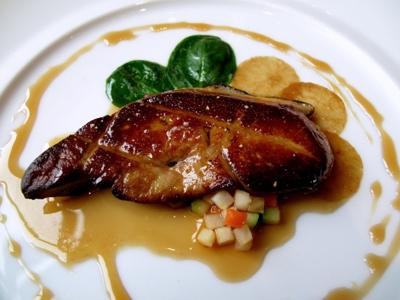
Consider the cooking process
Raspberry sauce in French cuisine is part of many dishes. The meaning of the sauce is to get raspberry juice, in which there will be no pulp and seeds. How to achieve this? Just put the berries in a steam bath and wait for the raspberries to release their juice (just don't rub the berries). A medium-sized apple needs to be peeled and the core removed. Sprinkle it with powdered sugar and cane sugar, put honey inside. Put the apple in a preheated oven to 180 C for 15 minutes. We dissolve cane sugar and honey in a pan, as a result we get caramel. Pour the apple with it and put it in the oven for another 5 minutes. We put the goose liver on a napkin to remove excess fat, make small cuts, salt and pepper on both sides. We take a dry frying pan and heat it over a fire, then in for 2 fry the liver for a minute and put it on a napkin to remove the fat. Now you need to prepare the dish for serving. As decorations, we use blueberries, black bread toasts and an apple slice, which was previously dried. We place the apple in the center of the plate and pour over it with raspberry sauce. We put croutons on it and on top - goose liver. To complete the dish, put blueberries, dried apple and again - raspberry sauce. I think now you more or less understand what foie gras is.
The famous delicacy of foie gras, along with frog legs and croissants, is associated with France all over the world. A dish of light pink color and a delicate creamy flavor, obtained from the liver of a duck or goose. Birds raised on special farms are forcibly fattened, due to which their liver increases by 8-10 times. So - foie gras, what is it? About the history of the popular dish, the subtleties of cooking and the useful qualities of the product, we will consider in our article.
Despite the fact that France is called the birthplace of this aristocratic dish, this delicacy originally appeared in ancient egypt. The ancient Egyptians noticed that the liver of fattened geese or wild ducks, which gain weight before a long flight, has a particularly delicate taste. Subsequently, a delicious dish traveled around the world, but it was the French who finally improved the recipe for the dish and set up the production of the product on an industrial scale.
In the 18th century, a certain Marquis de Contade, in preparation for the reception of guests, instructed his cook to prepare an unusual dish that could surprise all those invited. Without thinking twice, the cook mixed minced bird's liver with bacon, and used the resulting consistency as a filling for the dough. The fame of the new meal spread throughout the country, and foie gras which in French means " fatty liver”, has become the pride of the national cuisine.
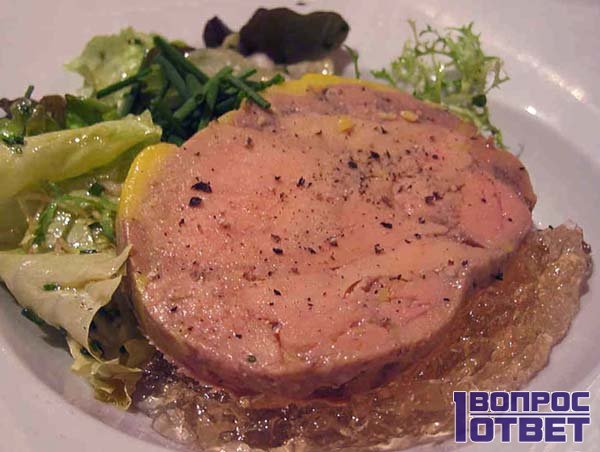
Initially, as the main ingredient, foie gras included goose liver. Now about 90% of all products are made from duck liver. This is due to the fact that the goose is a bird that is especially demanding in terms of self-care, and this, in turn, leads to an increase in the cost of the product. For future food, ducklings of two breeds are grown:
The first month of their life, ducklings are formed naturally, after which they begin to receive an unlimited amount of food. After 4 months, the living creatures begin to be forced to feed, bringing the weight of the liver to 600-700 grams.
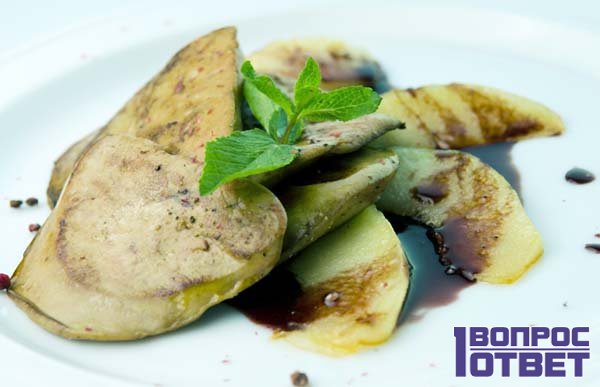
This gastronomic masterpiece can be prepared not only by an experienced chef, but also by any housewife. There are a lot of recipes. Let's take a look at two of them.
Classic foie gras tablet .
Pretty affordable products, with the exception of an expensive truffle, which, without losing taste, replaced by porcini mushroom.
Cooking process:
Fried foie gras.
This recipe is considered one of the most common. For cooking you will need:
Cooking process:
When frying, add oil to the pan is not worth it. The liver, during heat treatment, releases a huge amount of its own fat, on which it cooks. While cooking in the oven, baste the foie gras with your own fat every 5 minutes.
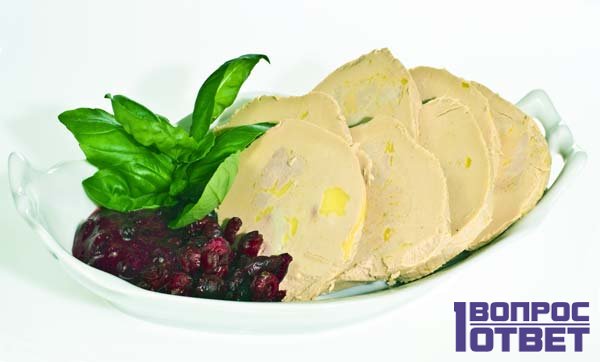
The presence of vitamins and amino acids in the composition of goose liver is not main reason the popularity of this delicacy. But nonetheless, foie gras lovers will be interested to know what:
A properly prepared dish can provide the body of an adult with the daily norm of most vitamins and minerals.
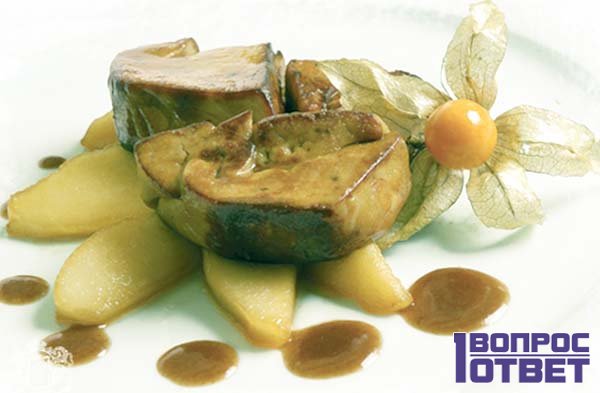
A person who has tried foie gras for the first time will be very surprised when he learns about the number of animal protection organizations demanding a ban on this dish. The reason lies in the inhumane attitude to the cultivation of poultry, namely to force-feeding. In some countries and in some states of America, the production of poultry for this delicacy is prohibited by law.
Supporters claim that they do not perform any violent actions on geese, and after stopping " gavage”(this is what force feeding is called) all the organs of the bird take on normal sizes, without subsequently causing animal pain and discomfort.
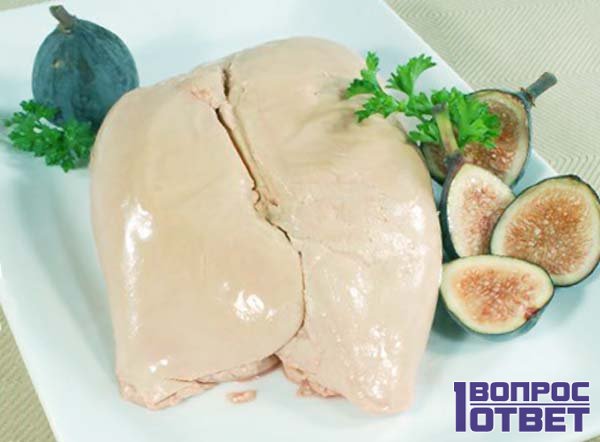
You have discovered the most favorite treat million gourmets from all over the world - foie gras. What is it people learned about 4000 years ago, and now this dish has become one of the most popular delicacies of our time. This gourmet dish, traditional for Western Europe, the USA and Japan, has also found fans in our country. We hope that these recipes will help embellish festive table and surprise your family and friends with an unusual dish.